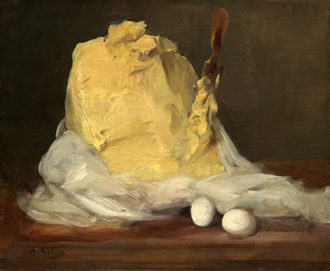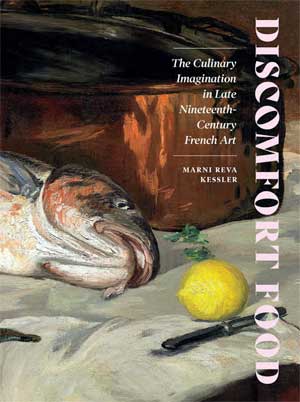
In Discomfort Food, I argue that representations of food are profoundly evocative, able to convey material and immaterial possibilities that are inconsistent with their seemingly mundane subject matter. Depictions of the alimentary resonate far beyond the physical bounds of the picture plane, tying us to both the sensory present and the fullness of the past, to our memories, our families, our traditions, our happinesses, and our losses. And these works are, of course, fixed, too, to the artists who created them, to sentient beings who lived and ate, who loved and experienced sadness.
At the center of my study are works by Édouard Manet, Antoine Vollon, Gustave Caillebotte, and Edgar Degas that, for most, conjure unbroken narratives of gustatory pleasures. But, as I show, each of these works also engage more nuanced and even unsettling associations. These pictures of fish, fruit, butter, and meat, things so apparently anodyne, are, in my analysis, haunted by anxiety, nostalgia, and melancholy for and about family, home, and the past. Rooted in histories, these images immerse us, too, in the present, in the smell and taste and feel of what we see portrayed. Our visceral responses, I thus suggest, matter deeply to our experience of representations of food, and this sensitivity to their affective qualities helps us to construe their utter capaciousness, their tensions and contradictory effects, their abilities to signify across a spectrum of unalloyed beauty and base disgust. These pictures of things so quotidian and that we associate with a range of culinary pleasures, each in their own unique ways demonstrate, too, their own inherent displeasures.
In considering—along with the scholarly—such subjective nuances and how they might be articulated in depictions of food, I shift away from the prevailing tendency to categorize them simply as still lifes and toward more analytic scrutiny of them as representations containing tangible critical capacities and expressive force that we more readily associate with real food. With this project, I thus seek to augment our study of images of edible things by demonstrating that certain linear models and classifications fail to do justice to the ways in which they are singularly suggestive, engendering distinctly visceral reactions of the sort that we may have in relation to a painting of, say, flowers, insects, books, or shells. Depictions of food are deeply complex and individual. They inevitably summon not just some of the more fugitive aspects of everyday life but also the intricate webs that constitute our memories and the myriad pleasures and discomforts that may accompany our thoughts of them. They are always richly evocative, capable of conveying delight and the promise of culinary satisfaction even as they sublimate their corollary. By introducing the transgressive power of food into analysis of representations of it, I thus expose the profoundly personal and messier aspects of images that take as their subject something so fundamental to human experience.
Although I didn’t know it at the time, this book took root during a visit years ago to the National Gallery of Art when I happened upon Antoine Vollon’s Mound of Butter. I was swept in, of course, by the subject and dazzled by the sumptuous licks of paint that somehow combine to deliver the essence of butter. I imagined the artist’s hand whipping dense cushions of pigment into this luminous mound, his gestures carrying an echo of the act of smoothing butter upon a slice of freshly baked bread. But even as I reveled in this painting’s radiance, I also sensed the stir of disquiet. The very downy peaks that captured my attention, I came to see, are met with oily planes and flashes of white and paler yellow that disclose the unpleasant possibility that Vollon proffers butter that is in the process of melting and spoiling. The milk product’s inherent instability—the artist’s rendering of it mingled with my knowledge of it—emerging as a screen through which I encountered the painting. More astonishingly, I also detected within Vollon’s scrambled eddies of paint the form of a head, further infusing an unseemliness that conflicts with butter’s beloved status in the culinary imagination.
I was working on a different book at the time, so I tucked this painting into the back of my mind. Several years later, I submitted an abstract to a conference panel titled “Food into Art.” That paper led to another one and then to the opportunity to write an article. Only gradually and over several more years did I realize that I could turn the research I had been doing for a book on Degas’s family portraits into two articles and write this book about late nineteenth-century French representations of food in which Vollon’s astonishing painting would prominently feature. I had absolutely no idea then that my research for this chapter would lead me to discover the dark underside of butter’s pervasive adulteration and that I would conclude that Vollon models the substance into a cipher for expressing those contemporary anxieties about its safety.
The other three chapters also focus on one or two works and engage my claim that pictures of edibles are dense with unanticipated significance. Édouard Manet’s Fish (Still Life) superficially appears to depict the ingredients for a humble stew and a vessel in which to cook it. But piercing this fragile veneer of imagined contentment is a surprising unsettledness, a conjuring of death and putrefaction that brings us to the corpses on display at the new Paris Morgue. Gustave Caillebotte’s rendition of a greengrocer’s arrangement of produce in Fruit Displayed on a Stand, I argue, formally echoes the radiating grid of Haussmann’s Paris and the multicolored maps that represented the changing urban fabric even as it mourns the farmlands on which the fruits were grown. A painting and a photograph by Edgar Degas feature vividly rendered meats that sharply exceed their purely culinary value, invoking instead contemporary debates about animal butchery and anatomical cross-section views of the human body.

If a reader picked up Discomfort Food at a bookstore—enticed, I hope, by the suggestive cover—I would be so pleased if they looked through the introduction “Beginnings,” where I establish the contours of my argument, and the epilogue “‘Ending with the Beginning,’” in which I return to the more personal aspect of the book’s central premise, that representations of food have the ability to embody and express significance not only for the artist who imagined the work in the first place, but also for the viewer who may look at it however many years later. But even more, inherent in the titles of both the introduction and the epilogue is the notion that my own beginnings—in my family of origin, as a graduate student, as an academic—are profoundly braided with the analysis and archival research that form the basis of the study and are, to my mind, central to the project’s texture and ultimately, to its realization.
If a browser could indulge me further and read the short section in chapter one titled “The Lure of the Painting,” they could see even more concretely exactly how my beginnings are woven into the book’s core. Here, I describe the particular and very personal pull of Manet’s Fish (Still Life) and in so doing, I take a risk by both arguing and demonstrating that intermingling the scholarly and archival with the deeply personal yields rich interpretive possibility. Defying the (largely unspoken, but nevertheless entrenched) notion that academic work should remain distinct from the private, I pursue some of the reasons why this canvas “simultaneously beckons and repulses me” and find that it, quite unexpectedly, brings me to certain of my own memories. My delight in the painting’s intensely visceral materiality is tinged, I find, with measures of revulsion, sorrow, mournfulness, and longing, and I trace those visceral responses to fishing as a girl in the Catskill Mountains, to a photograph of my grandfather that sat on my grandmother’s dresser, and to wistful thoughts of my mother cooking in our kitchen in Brooklyn. “For even images of as-yet-unprepared raw ingredients [in Manet’s painting],” I discover, “can bear the ineffable traces of the effable past.” The sense of loss and sorrow that undergirds my interpretation of Fish (Still Life), also has the effect of greatly enhancing it. This willingness to allow my own thoughts to unspool, to reach back to long-forgotten memories even as I comb the archives and plumb the depths of the surface of the painting, I claim, is what leads me to see the deep poignance of this scattered array of piscine creatures and a lemon that is the color of the sun. My own memories, my losses and my sorrows, in other words, also “illuminate my path.”
I hope that Discomfort Food will convince readers that representations of food—those created in late nineteenth-century France and otherwise—should not be relegated to the category still life. While I recognize the works’ connections to seventeenth-century Dutch and eighteenth-century French still life precedents, with this project I seek to amplify and deepen our understanding of images of things that we consume by demonstrating that they should instead be appreciated in more generous historical, archival, theoretical, material, and visceral ways. We might savor their many and multifaceted resonances as we would a fine meal, relished for the complexity and richness inherent in them.
If the theories of academic practice establish the armature of this study, my own history lies at its beating heart. I didn’t know this when I started out, but during the years in which I worked on the book, I came to understand more about why the pictures upon which I focus matter so much to me. Why, for example, the mullet in Manet’s painting seemed to be so melancholy; why his eel disturbed me enough to think that I couldn’t write about the image; and why that unbearably beautiful lemon and those clattery oysters lured me back to the painting, unfurling memories of my mother making stuffed clams in our kitchen in Brooklyn. And something of the wedge of raw meat on the ground beside the sorrowful man in Degas’s painting led me, however circuitously, to my family’s holiday dinner table, to the brisket that we have eaten for generations, simmered for hours in that particular heady fusion of onions and garlic and cranberries and raspberry preserves. Such memories drove me, whether I always realized it or not, to search for these images’ most expansive resonances and material depths. Braiding the strands of personal experience and scholarly analysis, melding them as one would the ingredients in a recipe, I hope my book demonstrates, enriches and makes more complex the quality of the proverbial final dish. For, images of food, like their analogues in our world, touch us deeply. They are decidedly evocative and always personal—for the artist then as for the viewer now—and their sensory and conceptual dimensions seemingly endless in ways both concrete and ineffable.
Finally, I hope that this book will appeal to a broad range of readers. Blending academic writing and research with evocative and suggestive prose, I took certain risks that I couldn’t have taken as a young assistant professor. It’s quite liberating to be able to do the kind of writing and research that gives me the most pleasure and that also makes the book accessible to a wide readership. We all eat, no matter who we are or where or when we live(d). I sincerely hope that Discomfort Food will contribute to the many and varied conversations about food and its instability, historically and today, and that in so doing, it might expand our understanding of representations of one of the most fundamental things that unites as human beings.


Marni Reva Kessler is Professor and Director of Graduate Studies in the Kress Foundation Department of Art History at the University of Kansas, where she teaches courses on 18th- and 19th-century European art and critical theory and methodology. In addition to Discomfort Food: The Culinary Imagination in Late Nineteenth-Century French Art, which is the focus of her Rorotoko interview, she is also the author of Sheer Presence: The Veil in Manet’s Paris (University of Minnesota Press, 2007) as well as book chapters and articles on topics related to portraiture, urbanism, photography, food, and fashion in the work of such artists as Manet, Degas, Caillebotte, Morisot, Monet, and Vuillard.